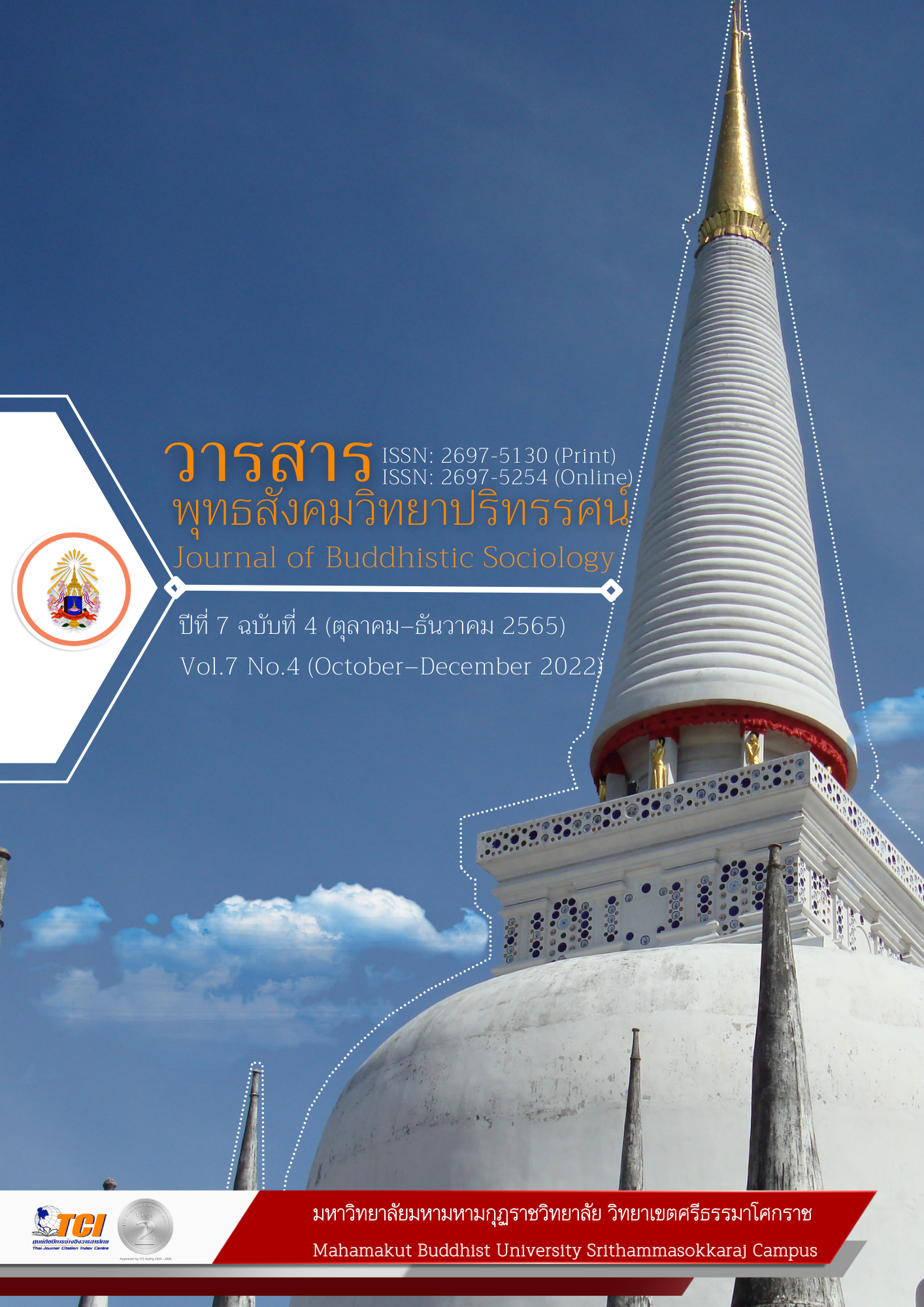STRUCTURE OF PASSIVE VOICE IN THAI VERSION OF BRAVE NEW WORLD
Main Article Content
Abstract
This research article aimed to present the study results on the structure of passive voice found in a Thai version of Brave New World book published by Medsai Publishing (translated from the original English language published in 1932). The data were collected from sentences with the helping verb or the word “/thuk/,” showing that the person or object experienced or received the action. The research instrument was tables used for recording the contexts with passive voice found in the translated version of Brave New World. The results revealed a total of 89 passive sentences that could be classified into three types: 1) Passive voice in complex sentences was the most frequently found in 49 sentences or 55.05 percent and could be further classified into 1.1) the passive voice in the main clause of complex sentences found in 15 sentences or 16.85 percent, and 1.2) the passive voice in the subordinate clause of complex sentences found in 34 sentences or 38.20 percent; 2) Passive voice in simple sentences was the second most frequently found in 27 sentences or 30.34 percent, and 3) Passive voice in compound sentences was the least frequently found in 13 sentences or 14.61 percent. The research result reflected that the structure of the passive voice was complicated and required modifiers of the contexts to clarify the meaning, resulting in the passive voice mainly being found in complex sentences.
Article Details

This work is licensed under a Creative Commons Attribution-NonCommercial-NoDerivatives 4.0 International License.
References
คุณบรรจบ พันธุเมธา. (2562). ลักษณะภาษาไทย (พิมพ์ครั้งที่ 24). กรุงเทพฯ: สำนักพิมพ์มหาวิทยาลัยรามคำแหง.
ชัชวาล ศรีทอง. (2558). กรรมวาจกภาษาสเปนจากภาษาข่าวออนไลน์: กรรมวาจกแบบสะท้อนหน่วยสร้าง Se และกรรมวาจกหน่วยสร้างกลุ่มคำกริยา Ser. วารสารศิลปศาสตร์ มหาวิทยาลัยสงขลานครินทร์ วิทยาเขตหาดใหญ่, 7(2), 132-156.
พัชรี โภคาสัมฤทธิ์. 2552. จดหมายถึงบรรณาธิการในคอลัมน์โพสต์แบก หนังสือพิมพ์บางกอกโพสต์: การวิเคราะห์เชิงภาษาศาสตร์สังคมและวัจนปฏิบัติศาสตร์. วารสารพัฒนบริหารศาสตร์ NIDA Development Journal, 49,(3), 187-220.
ภวัจน์ แต่รุ่งเรือง และวิโรจน์ อรุณมานะกุล. (2558). กลวิธีลักลอกงานวิชาการภาษาไทย: การวิเคราะห์ทางภาษาศาสตร์. วารสารภาษาและภาษาศาสตร์ ภาควิชาภาษาศาสตร์ คณะศิลปศาสตร์ มหาวิทยาลัยธรรมศาสตร์, 34(1), 38-65.
ราชบัณฑิตยสถาน. (2562). ประโยค. ใน วิจินตน์ ภาณุพงศ์ และคณะ (บ.ก.), บรรทัดฐานภาษาไทย เล่ม 3: ชนิดของคำ วลี ประโยคและสัมพันธสาร (พิมพ์ครั้งที่ 2). (91-116). กรุงเทพฯ: สถาบันภาษาไทย สำนักวิชาการและมาตรฐานการศึกษา สำนักงานคณะกรรมการการศึกษาขั้นพื้นฐาน กระทรวงศึกษาธิการ.
ราตรี ธันวารชร และอนันต์ เหล่าเลิศวรกุล. (2561). ประโยค. ใน วิจินตน์ ภาณุพงศ์ และคณะ (บ.ก.), บรรทัดฐานภาษาไทย เล่ม 3: ชนิดของคำ วลี ประโญคและสัมพันธสาร (พิมพ์ครั้งที่ 2). (หน้า 91-116). กรุงเทพฯ: สถาบันภาษาไทย สำนักวิชาการและมาตรฐานการศึกษาสำนักงานคณะกรรมการการศึกษาขั้นพื้นฐาน กระทรวงศึกษาธิการ.
วิจินตน์ ภาณุพงศ์ และอนันต์ เหล่าเลิศวรกุล. (2561). ชนิดของคำ. ใน วิจินตน์ ภาณุพงศ์ และคณะ (บ.ก.), บรรทัดฐานภาษาไทย เล่ม 3: ชนิดของคำ วลี ประโยคและสัมพันธสาร (พิมพ์ครั้งที่ 2). (16-65). กรุงเทพฯ: สถาบันภาษาไทย สำนักวิชาการและมาตรฐานการศึกษา สำนักงานคณะกรรมการการศึกษาขั้นพื้นฐาน กระทรวงศึกษาธิการ.
อัญชลี สิงห์น้อย วงศ์วัฒนา. (2556). หน่วยสร้างกรรมวาจกในภาษาไทย: การวิเคราะห์ในแนวไวยากรณ์หน้าที่นิยมแบบลักษณ์ภาษา. วารสารภาษาและภาษาศาสตร์, 31(2), 1-34.
อัลดัส ฮักซเลย์. (2523). โลกวิไลซ์ [Brave New World] (ธีรพงศ์ ธนสุทธิพิทักษ์, แปล). นครศรีธรรมราช: สำนักพิมพ์เม็ดทราย. (ต้นฉบับพิมพ์ปี ค.ศ. 1932)


